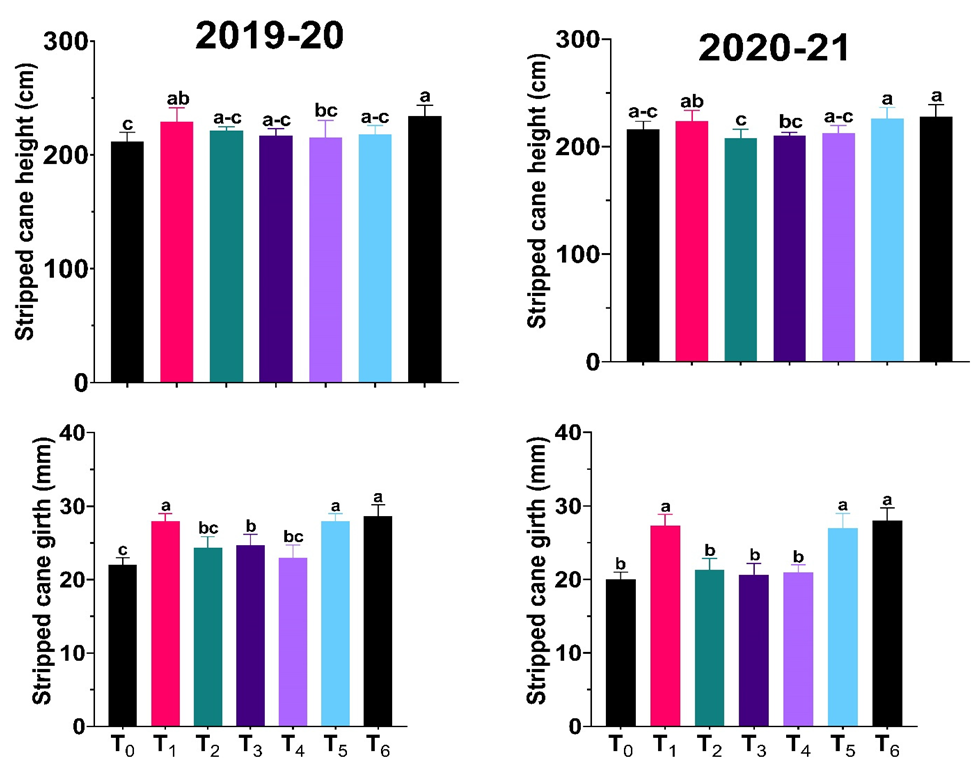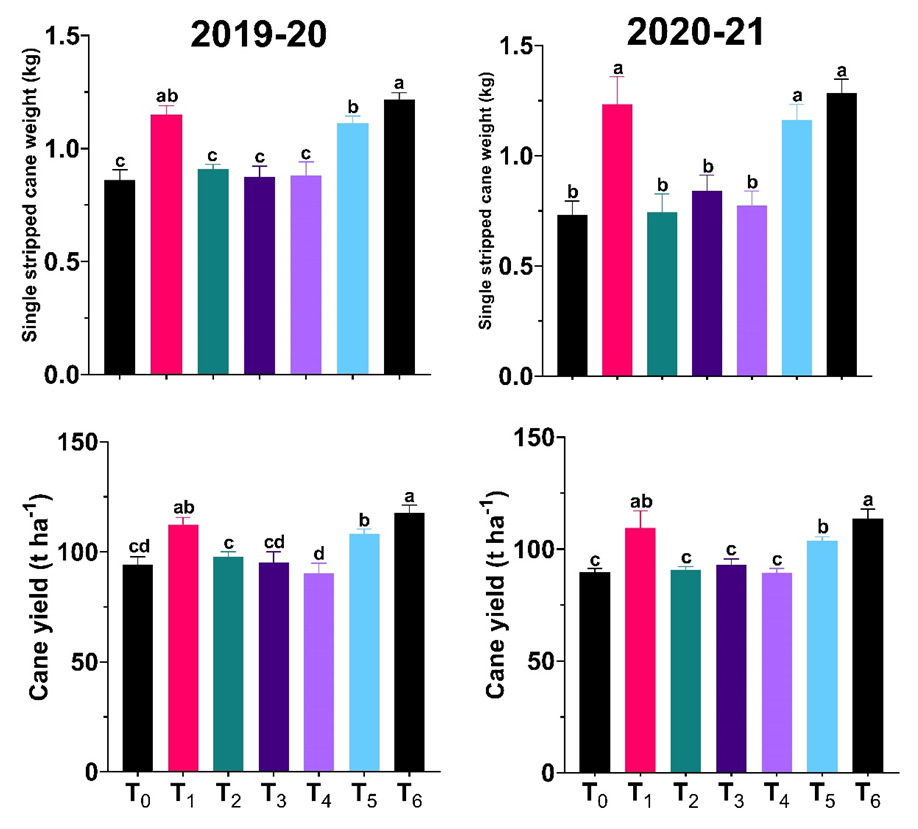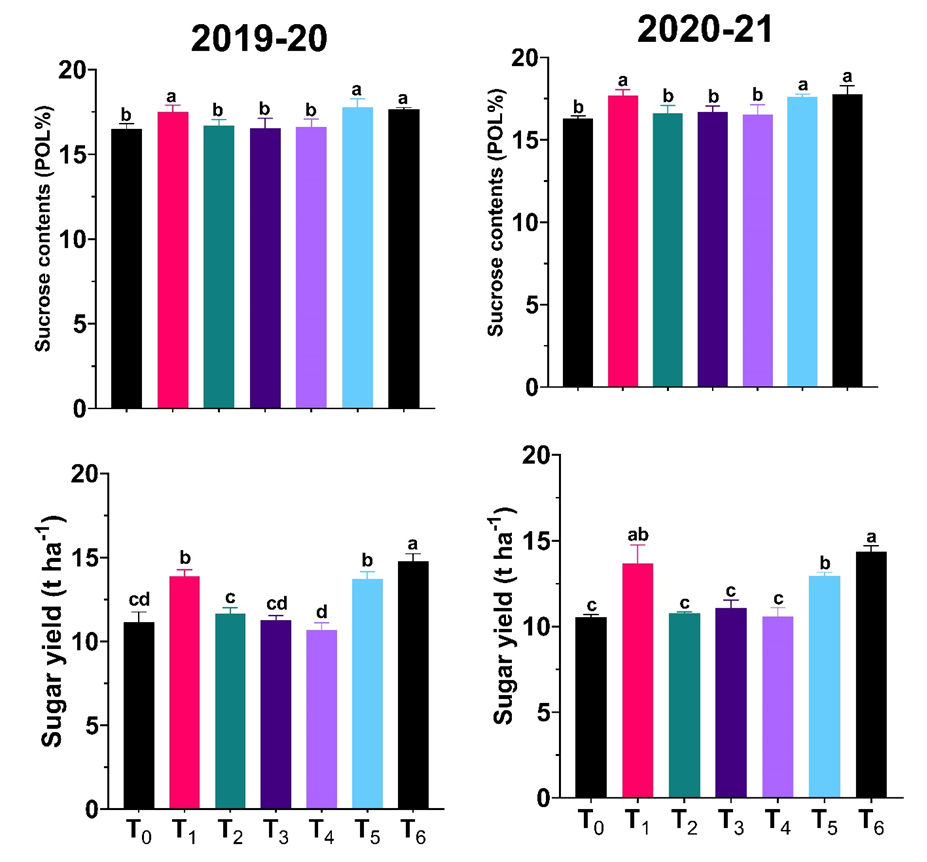Balanced Use of Zn, Cu, Fe, and B Improves the Yield and Sucrose Contents of Sugarcane Juice Cultivated in Sandy Clay Loam Soil
Abstract
:1. Introduction
2. Materials and Methods
2.1. Soil Analysis
2.2. Field Experiment
2.3. Data Collection
2.4. Economic Analysis
2.5. Statistical Analysis
3. Results and Discussion
3.1. Growth and Yield Parameters
3.2. Quality Parameter
3.3. Economic Analysis
4. Conclusions
Author Contributions
Funding
Institutional Review Board Statement
Informed Consent Statement
Data Availability Statement
Acknowledgments
Conflicts of Interest
References
- Hussain, S.; Khaliq, A.; Mehmood, U.; Qadir, T.; Saqib, M.; Iqbal, M.A.; Hussain, S. Sugarcane production under changing climate, effects of environmental vulnerabilities on sugarcane diseases, insects and weeds. In Sugarcane Production-Agronomic, Scientific and Industrial Perspectives; IntechOpen: Rijeka, Croatia, 2018. [Google Scholar]
- Ehsanullah, A.S.; Raza, S.A.; Riaz, M.M.; Abbas, A.; Yousif, M.M.; Xu, Y. Optimizing row spacing to ameliorate the productivity of spring sugarcane (Saccharum officinarum L.). Agric. Sci. 2016, 7, 531–538. [Google Scholar]
- Mangrio, N.; Kandhro, M.N.; Soomro, A.A.; Mari, N.; Shah, Z.H. Growth, yield, and sucrose percent response of sugarcane to zinc and boron application. Sarhad J. Agric. 2020, 36, 459–469. [Google Scholar] [CrossRef]
- Madhuri, K.V.N.; Sarala, N.V.; Hemanth Kumar, M.; Subba Rao, M.; Giridhar, V. Influence of micronutrients on yield and quality of sugarcane. Sugar Tech 2013, 15, 187–191. [Google Scholar] [CrossRef]
- Ghaffar, A.; Ehsanulah, N.A.; Khan, S.H. Influence of zinc and iron on yield and quality of sugarcane planted under various trench spacings. Pak. J. Agric. Sci. 2011, 48, 25–33. [Google Scholar]
- Wu, Q.; Zhou, W.; Chen, D.; Cai, A.; Ao, J.; Huang, Z. Optimizing soil and fertilizer phosphorus management according to the yield response and phosphorus use efficiency of sugarcane in southern China. J. Soil Sci. Plant Nutr. 2020, 20, 1655–1664. [Google Scholar] [CrossRef]
- da Silva, P.C.R.; Paiva, P.E.B.; de Oliveira Charlo, H.C.; de Miranda Coelho, V.P. Slow-release fertilizers or fertigation for sugarcane and passion fruit seedlings? Agronomic performance and costs. J. Soil Sci. Plant Nutr. 2020, 20, 2175–2181. [Google Scholar] [CrossRef]
- Stanislawska-Glubiak, E.; Korzeniowska, J. Effect of Salicylic Acid Foliar Application on Two Wheat Cultivars Grown under Zinc Stress. Agronomy 2022, 12, 60. [Google Scholar] [CrossRef]
- Naeem, A.; Aslam, M.; Ahmad, M.; Asif, M.; Yazici, M.A.; Cakmak, I.; Rashid, A. Biofortification of Diverse Basmati Rice Cultivars with Iodine, Selenium, and Zinc by Individual and Cocktail Spray of Micronutrients. Agronomy 2022, 12, 49. [Google Scholar] [CrossRef]
- Scheid, S.S.; Faria, M.G.I.; Velasquez, L.G.; do Valle, J.S.; Gonçalves, A.C.; Dragunski, D.C.; Colauto, N.B.; Linde, G.A. Iron biofortification and availability in the mycelial biomass of edible and medicinal basidiomycetes cultivated in sugarcane molasses. Sci. Rep. 2020, 10, 12875. [Google Scholar] [CrossRef]
- Crusciol, C.A.C.; McCray, J.M.; de Campos, M.; do Nascimento, C.A.C.; Rossato, O.B.; Adorna, J.C.; Mellis, E.V. Filter cake as a long-standing source of micronutrients for sugarcane. J. Soil Sci. Plant Nutr. 2021, 21, 813–823. [Google Scholar] [CrossRef]
- de Lima Vasconcelos, R.; Cremasco, C.P.; de Almeida, H.J.; Garcia, A.; Neto, A.B.; Mauad, M.; Gabriel Filho, L.R.A. Multivariate behavior of irrigated sugarcane with phosphate fertilizer and filter cake management: Nutritional state, biometry, and agroindustrial performance. J. Soil Sci. Plant Nutr. 2020, 20, 1625–1636. [Google Scholar] [CrossRef]
- Bouyoucos, G.J. Hydrometer method improved for making particle size analysis of soils. J. Agron. 1962, 53, 464–465. [Google Scholar] [CrossRef]
- Page, A.L.; Miller, R.H.; Keeny, D.R. Methods of soil analysis (Part 2). In Chemical and Microbiological Properties; Agronomy 9; SSSA: Madison, WI, USA, 1982. [Google Scholar]
- Nelson, D.W.; Sommers, L.E. Total carbon, organic carbon, and organic matter. In Methods of Soil Analysis: Part 3—Chemical Methods; Bigham, J.M., Ed.; Agron. Inc.: Medison, WI, USA, 1996; pp. 961–1010. [Google Scholar]
- Olsen, S.R.; Cole, C.V.; Watanabe, F.S.; Dean, L.A. Estimation of Available Phosphorus in Soils by Extraction with Sodium Bicarbonate; Circular/United States Department of Agriculture: Wareham, WA, USA, 1954; p. 939. [Google Scholar]
- Ryan, J.; Estefan, G.; Rashid, A. Soil and Plant Analysis Laboratory Manual, 2nd ed.; International Center for Agricultural Research in Dry Areas: Aleppo, Syria, 2001. [Google Scholar]
- Lindsay, W.L.; Norvell, W.A. Development of a DTPA soil test method for zinc, iron, manganese, and copper. Soil Sci. Soc. Am. J. 1978, 42, 421–428. [Google Scholar] [CrossRef]
- Karami, S.; Yasrebi, J.; Safarzadeh Shirazi, S.; Whalen, J.K.; Ronaghi, A.; Ghasemi-Fasaei, R. Sugar processing residuals as an iron source for grain crops grown in calcareous soil. Commun. Soil Sci. Plant Anal. 2020, 51, 60–69. [Google Scholar] [CrossRef]
- Tamez, C.; Morelius, E.W.; Hernandez-Viezcas, J.A.; Peralta-Videa, J.R.; Gardea-Torresdey, J. Biochemical and physiological effects of copper compounds/nanoparticles on sugarcane (Saccharum officinarum). Sci. Total Environ. 2019, 649, 554–562. [Google Scholar] [CrossRef]
- Marangoni, F.F.; Otto, R.; de Almeida, R.F.; Casarin, V.; Vitti, G.C.; Tiritan, C.S. Soluble sources of zinc and boron on sugarcane yield in Southeast Brazil. Sugar Tech 2019, 21, 917–924. [Google Scholar] [CrossRef]
- Spencer, G.L.; Meade, G.P. Cane Sugar Hand Book, 9th ed.; Wiley: New York, NY, USA, 1963. [Google Scholar]
- CIMMYT. From Agronomic Data to Farmer’s Recommendations: An Economics Training Manual; CIMMYT: Texcoco, Mexico, 1998; pp. 31–33. [Google Scholar]
- Steel, R.G.D.; Torrie, J.H.; Dickey, D. Principles and Procedures of Statistics: A Biometrical Approach, 3rd ed.; McGraw Hill Book Co., Inc.: New York, NY, USA, 1997. [Google Scholar]
- Franco, H.C.J.; Mariano, E.; Vitti, A.C.; Faroni, C.E.; Otto, R.; Trivelin, P.C.O. Sugarcane response to boron and zinc in Southeastern Brazil. Sugar Tech 2011, 13, 86–95. [Google Scholar] [CrossRef]
- Wu, W.; Fu, W.; Alatalo, J.M.; Ma, Z.; Bai, Y. Effects of Coupling Water and Fertilizer on Agronomic Traits, Sugar Content and Yield of Sugarcane in Guangxi, China. Agronomy 2022, 12, 321. [Google Scholar] [CrossRef]
- Oliva, K.M.E.; da Silva, F.B.V.; Araújo, P.R.M.; de Oliveira, E.C.A.; do Nascimento, C.W.A. Amorphous silica-based fertilizer increases stalks and sugar yield and resistance to stalk borer in sugarcane grown under field conditions. J. Soil Sci. Plant Nutr. 2021, 21, 2518–2529. [Google Scholar] [CrossRef]
- Aslam, M.; Ali, Z.; Chattha, A.A. Effect of soil-applied micronutrients on the growth and yield of sugarcane. Pak. Sugar J. 2004, 19, 2–34. [Google Scholar]
- Singh, A.; Gupta, A.K.; Srivastava, R.N.; Lal, K.; Singh, S.B. Response of zinc and manganese to sugarcane. Sugar Tech 2002, 4, 74–76. [Google Scholar] [CrossRef]
- Wang, J.J.; Kennedy, C.W.; Viator, H.P.; Arceneaux, A.E.; Guidry, A.J. Zinc fertilization of sugarcane in acid and calcareous soils. J. Am. Soc. Sugar Technol. 2005, 25, 49–61. [Google Scholar]
- Balaji, T.; Mani, S.; Saravanan, A.; Rao, T.N. Balanced fertilization for maximizing the yield of sugarcane in Periyar Vaigai command area. Ind. Sugar 2006, 56, 43–50. [Google Scholar]
- Nobre Cunha, F.; Batista Teixeira, M.; Cabral da Silva, E.; Furtado da Silva, N.; Teixeira Silva Costa, C.; Marques Vidal, V.; Alves Morais, W.; Nazário Silva dos Santos, L.; Cabral Filho, R.; Karen Matias Alves, D.; et al. Productive potential of nitrogen and zinc fertigated sugarcane. Agronomy 2020, 10, 1096. [Google Scholar] [CrossRef]
- Pawar, M.W.; Joshi, S.S.; Amodkar, V.T. Effect of foliar application of phosphorus and micronutrients on enzyme activities and juice quality in sugarcane. Sugar Tech 2003, 5, 161–165. [Google Scholar] [CrossRef]
- Dhanasekaran, K.; Bhuvaneswari, R. Effect of zinc and iron humate application on the yield and quality of sugarcane. Ind. Sugar 2004, 53, 907–912. [Google Scholar]
- Thangavelu, S. Zinc and sugarcane production. Rev. Ind. Sugar 2007, 57, 39–46. [Google Scholar]
- Shahzad, S.; Shokat, S.; Fiaz, N.; Hameed, A. Impact of yield and quality-related traits of sugarcane on sugar recovery. J. Crop. Sci. Biotechnol. 2017, 20, 1–7. [Google Scholar] [CrossRef]
- El-Mageed, A.; Taia, A.; Rady, M.O.; Semida, W.M.; Shaaban, A.; Mekdad, A.A. Exogenous micronutrients modulate morpho-physiological attributes, yield, and sugar quality in two salt-stressed sugar beet cultivars. J. Soil Sci. Plant Nutr. 2021, 21, 1421–1436. [Google Scholar] [CrossRef]
- Xu, N.; Bhadha, J.H.; Rabbany, A.; Swanson, S.; McCray, J.M.; Li, Y.C.; Strauss, S.L.; Mylavarapu, R. Crop Nutrition and Yield Response of Bagasse Application on Sugarcane Grown on a Mineral Soil. Agronomy 2021, 11, 1526. [Google Scholar] [CrossRef]
- Grzanka, M.; Smoleń, S.; Skoczylas, Ł.; Grzanka, D. Biofortification of Sweetcorn with Iodine: Interaction of Organic and Inorganic Forms of Iodine Combined with Vanadium. Agronomy 2021, 11, 1720. [Google Scholar] [CrossRef]
- Sentíes-Herrera, H.E.; Trejo-Téllez, L.I.; Volke-Haller, V.H.; Cadena-Íñiguez, J.; Sánchez-García, P.; Gómez-Merino, F.C. Iodine, silicon, and vanadium differentially affect growth, flowering, and quality components of stalks in sugarcane. Sugar Tech 2018, 20, 518–533. [Google Scholar] [CrossRef]
- Rakoczy-Lelek, R.; Smoleń, S.; Grzanka, M.; Ambroziak, K.; Pitala, J.; Skoczylas, Ł.; Liszka-Skoczylas, M.; Kardasz, H. Effectiveness of foliar biofortification of carrot with iodine and selenium in a field condition. Front. Plant Sci. 2021, 12, 656283. [Google Scholar] [CrossRef]
- Mehmood, S.; Ahmed, W.; Rizwan, M.; Imtiaz, M.; Elnahal, A.S.M.A.; Ditta, A.; Irshad, S.; Ikram, M.; Li, W. Comparative efficacy of raw and HNO3-modified biochar derived from rice straw on vanadium transformation and its uptake by rice (Oryza sativa L.): Insights from photosynthesis, antioxidative response, and gene-expression profile. Environ. Pollut. 2021, 289, 117916. [Google Scholar] [CrossRef] [PubMed]
- Imtiaz, M.; Ashraf, M.; Rizwan, M.S.; Nawaz, M.A.; Rizwan, M.; Mehmood, S.; Yousaf, B.; Yuan, Y.; Mumtaz, M.A.; Ditta, A.; et al. Vanadium toxicity in chickpea (Cicer arietinum L.) grown in red soil: Effects on cell death, ROS, and antioxidative systems. Ecotoxicol. Environ. Saf. 2018, 158, 139–144. [Google Scholar] [CrossRef] [PubMed]
- Paul, G.C.; Mannan, M.A. An integrated nutrient management approach to improve sugar productivity. Sugar Tech 2007, 9, 28–35. [Google Scholar] [CrossRef]




| Properties | Before the Start of the Experiment | At the End of the Experiment |
|---|---|---|
| Sand (%) | 51 | 54.5 |
| Silt (%) | 25 | 20.5 |
| Clay (%) | 24 | 25 |
| Textural Class | Sandy clay loam | Sandy clay loam |
| ECe (dS m−1) | 2.10 | 2.22 |
| pH | 8.30 | 8.26 |
| Soil organic carbon contents (%) | 0.278 | 0.296 |
| Available P (mg kg−1) | 7.80 | 7.74 |
| Extractable K (mg kg−1) | 160 | 164 |
| Extractable Zn (mg kg−1) | 0.32 | 0.52 |
| Extractable Cu (mg kg−1) | 0.49 | 0.51 |
| Extractable Fe (mg kg−1) | 4.55 | 4.54 |
| Available B (mg kg−1) | 0.53 | 0.52 |
| 2019–2020 | |||||
|---|---|---|---|---|---|
| Sucrose Contents | Stripped Cane Girth | Stripped Cane Height | Sugar Yield | Single Stripped Cane Weight | |
| Stripped cane girth | 0.7142 *** | ||||
| Stripped cane height | 0.3888 NS | 0.5875 ** | |||
| Sugar yield | 0.7863 *** | 0.8592 *** | 0.6117 ** | ||
| Single stripped cane weight | 0.7786 *** | 0.7990 *** | 0.5620 ** | 0.9293 *** | |
| Cane yield | 0.6859 *** | 0.8248 *** | 0.6328 ** | 0.9853 *** | 0.9136 *** |
| 2020–2021 | |||||
| Sucrose Contents | Stripped Cane Girth | Stripped Cane Height | Sugar Yield | Single Stripped Cane Weight | |
| Stripped cane girth | 0.8814 *** | ||||
| Stripped cane height | 0.5221 * | 0.7685 *** | |||
| Sugar yield | 0.8554 *** | 0.8705 *** | 0.5675 ** | ||
| Single stripped cane weight | 0.8004 *** | 0.8686 *** | 0.6363 ** | 0.9327 *** | |
| Cane yield | 0.7987 *** | 0.8391 *** | 0.5574 ** | 0.9935 *** | 0.9300 *** |
| Treatments | Cost of Fertilizer ha−1 (US$) | Fixed Cost ha−1 (US$) | Total Expenditure ha−1 (US$) | Sugarcane Yield (kg ha−1) | Total Income ha−1 (US$) | Gross Income ha−1 (US$) | BCR | Increase over Control |
|---|---|---|---|---|---|---|---|---|
| Recommended NPK (Control) | 275.26 | 519.38 | 794.63 | 92,035 | 2189.37 | 1394.74 | 1.76 | - |
| Recommended NPK + Zn | 309.48 | 519.38 | 828.86 | 110,922 | 2638.65 | 1809.79 | 2.18 | 30 |
| Recommended NPK + Cu | 283.81 | 519.38 | 803.19 | 94,290 | 2243.01 | 1439.82 | 1.79 | 3 |
| Recommended NPK + Fe | 303.78 | 519.38 | 823.16 | 94,142 | 2239.49 | 1416.33 | 1.72 | 2 |
| Recommended NPK + B | 278.11 | 519.38 | 797.48 | 89,877 | 2138.03 | 1340.55 | 1.68 | −4 |
| Recommended NPK + (Zn + Cu + Fe + B as basal Half Dose) | 312.34 | 519.38 | 831.71 | 106,088 | 2523.68 | 1691.96 | 2.03 | 21 |
| Recommended NPK + (Zn + Cu + Fe + B as basal Full Dose) | 349.42 | 519.38 | 868.79 | 115,683 | 2751.93 | 1883.14 | 2.17 | 35 |
Publisher’s Note: MDPI stays neutral with regard to jurisdictional claims in published maps and institutional affiliations. |
© 2022 by the authors. Licensee MDPI, Basel, Switzerland. This article is an open access article distributed under the terms and conditions of the Creative Commons Attribution (CC BY) license (https://creativecommons.org/licenses/by/4.0/).
Share and Cite
Majeed, A.; Rashid, I.; Niaz, A.; Ditta, A.; Sameen, A.; Al-Huqail, A.A.; Siddiqui, M.H. Balanced Use of Zn, Cu, Fe, and B Improves the Yield and Sucrose Contents of Sugarcane Juice Cultivated in Sandy Clay Loam Soil. Agronomy 2022, 12, 696. https://doi.org/10.3390/agronomy12030696
Majeed A, Rashid I, Niaz A, Ditta A, Sameen A, Al-Huqail AA, Siddiqui MH. Balanced Use of Zn, Cu, Fe, and B Improves the Yield and Sucrose Contents of Sugarcane Juice Cultivated in Sandy Clay Loam Soil. Agronomy. 2022; 12(3):696. https://doi.org/10.3390/agronomy12030696
Chicago/Turabian StyleMajeed, Abdul, Imran Rashid, Abid Niaz, Allah Ditta, Aysha Sameen, Asma A. Al-Huqail, and Manzer H. Siddiqui. 2022. "Balanced Use of Zn, Cu, Fe, and B Improves the Yield and Sucrose Contents of Sugarcane Juice Cultivated in Sandy Clay Loam Soil" Agronomy 12, no. 3: 696. https://doi.org/10.3390/agronomy12030696
APA StyleMajeed, A., Rashid, I., Niaz, A., Ditta, A., Sameen, A., Al-Huqail, A. A., & Siddiqui, M. H. (2022). Balanced Use of Zn, Cu, Fe, and B Improves the Yield and Sucrose Contents of Sugarcane Juice Cultivated in Sandy Clay Loam Soil. Agronomy, 12(3), 696. https://doi.org/10.3390/agronomy12030696








